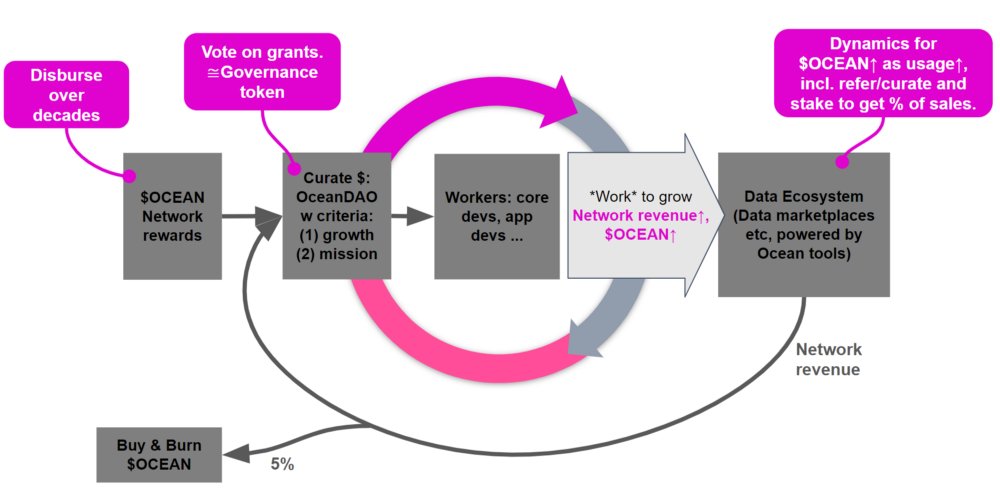New blog post, and a thread 👇
blog.oceanprotocol.com/the-web3-susta…
“How do we grow the ecosystem and make it truly self-sustaining?”
A common answer is grants programs. But:
What if grants are a black hole? Or, if grants end, will the ecosystem survive?
Evolution filters, mercilessly.
Web1 and Web2 companies explored many business models. Successful companies point to the successful models.
-have paid subscriptions for apps (SalesForce) and for content (NYT)
-tx fees for payment (Paypal), transit (Uber), etc
-affiliate programs (Kayak)
-and, ads (Google, FB) :/
It's a *loop*: revenue put into growth, allocated well, begets more revenue yet.
1. Amazon needed funds to get going in the first place.
2. It needed more funds to grow aggressively
Individuals can't do this, families can't do this, and cities can't do this.
But businesses can, and do.
That was for companies. Let's move on to dynamics of national economies.
If poorly allocated, it can lead to economic inequality, societal unrest and more for society's most vulnerable.
OK. We've talked about companies and nations, and how they sustain themselves. Recall that our goal here is to use that as *inspiration* for designing sustainability / growth models for Web3 projects.
So let's talk more about Web3 directly...
The founding team sustains itself by selling down more tokens for fiat over time, as they do work to improve the product.
The founding team needs to continually dip into its supply of tokens to fund itself.
That has problems:
-it's a finite supply
-each time they sell their $ TOKENs, their incentive to make the project succeed is further diminished
Funding can go to the founding team and other project teams. They all perform *work* to grow the $ TOKEN value and network revenue.
And the loop continues.
But there’s still one big problem: too little revenue, too late.
-rates too high --> project gets forke
-rates too low --> insufficient funding
Some may pull through. And most will be forced to stop, at which point the project begins its fade into oblivion.
Don't:
-disburse all the tokens at the beginning of the project
Do:
-disburse a large fraction over a longer period of time
-to the workers that are adding value to the project.
-to Buy & Burn $TOKEN (bottom left) and
-back to workers curated by the community according (center-left).
To catalyze growth and ensure decent funding in early days, "Network Rewards" (left) also feed into Workers.
Criterion 1. Each project must add sufficient value to the ecosystem. This means ROI > 1.0, to achieve snowball-effect growth.
Without this, the proposed project might as well be a Web2 project (!).
What I just described is not just theory. We're using it as basis of Ocean's design for long-term growth and sustainability.
-Community funding comes from 51% of OCEAN dedicated to Network Rewards and from Network Revenue
-funding is curated by OceanDAO
-it goes to teams who do *work* to grow the Data Ecosystem
-$ OCEAN is designed to grow with usage

blog.oceanprotocol.com/mission-values…
(We'll share more details of that in coming weeks.)
More usage of Ocean tools leads to:
-more OCEAN being staked, leading to more OCEAN demand, growing $OCEAN.
-more Network Revenue, which goes to burning and to OceanDAO, both which drive value.
1. a spreadsheet model
2. an agent-based simulator written from scratch in Python specifically for this project called TokenSPICE
The computer models align with the theory, and each other.
And with that, I conclude the description of the Web3 Sustainability Loop, and its application to @oceanprotocol.
The core idea is to direct both Network Revenue and Network Rewards to *work* that’s used for growth in a community-oriented fashion.
And, thanks to my excellent colleagues at Ocean Protocol for the collaboration as we build towards this:)
The ideas here started gestating in late 2019. I modeled them explicitly in TokenSPICE from Jan-Mar 2020.
Just as I was putting finishing touches on this piece, @ali01 posted an excellent tweetstorm describing a "Network Flywheel".
I conclude with a link to the blog post itself. Cheers!
/fin
blog.oceanprotocol.com/the-web3-susta…












